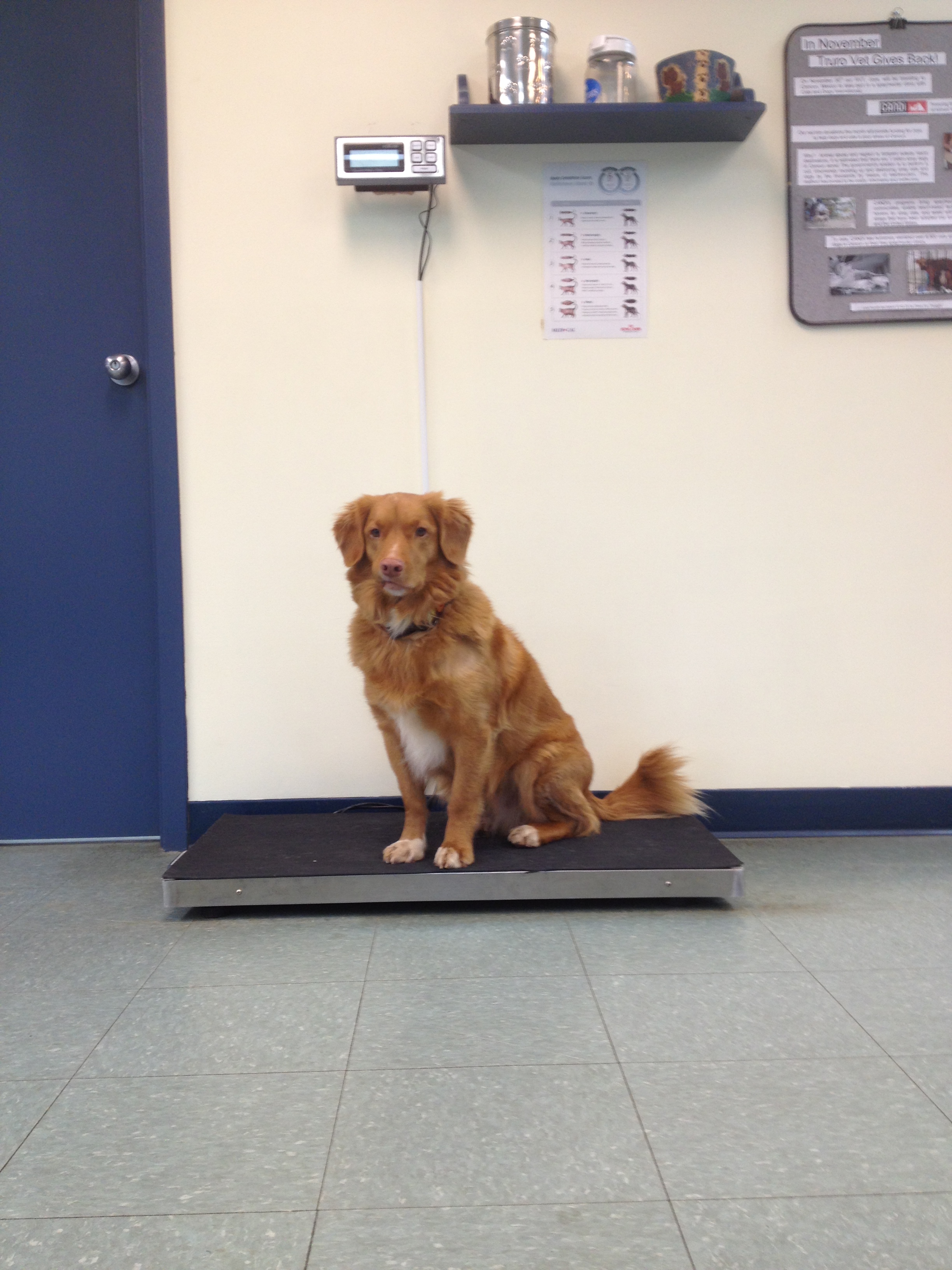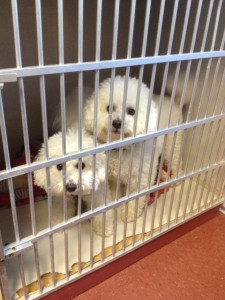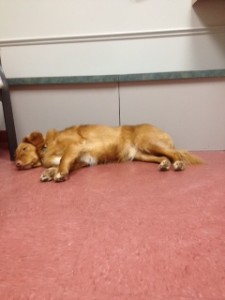Your Dog Hates The Vet? This One’s For You!
Courtesy of: Kaila and Dr. Gwen
Let’s face it…every dog is different! For some of our patients, a trip to the vet is their favourite event in the day (not counting breakfast, lunch and supper, of course). These dogs tear through our doors ready to greet everyone and have a fantastic time! Then there are the other dogs…the ones for whom a visit to the vet is a terrifying event, causing stress and anxiety that often carries right through the rest of the day. The big question is, how can we (both staff members and owners) try to help our dogs stay happy and stress-free while visiting the vet?
Here at Truro Vet we try to do everything we can to make your dog’s visit to the vet an enjoyable one; we want positive experiences and not negative ones. Coming to the vet can come with a lot of anxiety, not just for the dog, but for the owner as well. No owner likes to see his or her dog stressed out and worked up. Yet most of our patients love coming in. If yours is one of the poor dogs who does not love the visit, what can you do to make it at the very least tolerable and at the best (hopefully eventually) very fun?
- If you’re starting off with a new puppy, you are lucky enough to have a blank slate. Bring your puppy to puppy parties. We notice a HUGE difference in the puppies that have come here for Thursday Night Puppy Parties because they are pulling their owner to come IN rather then go out of the building. We have dogs that attended puppy parties years ago and still love to come to the vet because they had so many positive experiences at the vets. Oh and did we mention they are FREE?
- Bring your dog to Obedience Classes. This is great if your dog is too old to attend puppy parties; we have a variety of different classes for different levels that can help your dog associate the vet as a fun place full of positive interactions and treats.
- Visit us just for fun – stop by and get some treats. Have your dog sit on the scale for some freeze dried liver, and get some extra love and attention from the staff. These fun visits that aren’t associated with anything negative can really help to make the next visit be not quite as scary.
Now for some “tricks” you can teach your dog at home to make vet visits less stressful and more enjoyable for everyone involved. If you don’t know how to get started with any of the below behaviors contact us about training.
- Train your dog to LOVE a crate, even if you don’t use it at home (although we really recommend that you do). If your dog is in for any lengthy procedure they will be crated. It is a lot less stress on your pooch if they already enjoy being in the crate when they come to the vet then having to learn about a crate when they are already scared or painful.
- Train your dog to stand still and tolerate being handled all over. Practice some pushing on the abdomen, or an arm reaching over his back, picking up and stretching legs carefully, even holding him still for restraint. Don’t forget to get him used to you looking in their ears, eyes, and mouth.
- Teach your dog to lay on his side. This is a great body position for examination of legs and belly, also great position to lay in for nail trimmings or radiographs (X-rays).
- Make sure your dog is comfortable with having his paws held so that it isn’t a fight for the staff to trim his nails – causing your poor dog even more stress at the visit.
Even with all this preparation, some dogs are just plain worried about their time here at the hospital. There are a few ways that we can work together to lessen your best friend’s anxiety before it even starts.
- Book the appointment for the beginning of your vet’s work day or right after a lunch or dinner break. This will reduce the waiting time until the vet can see your pet. The less time to wait, the less time to worry.
- Ask when you book the appointment that you be allowed to be directed right into an exam room, away from other animals that might upset your dog. When you arrive, leave your dog in the car (if it is safe to do so) and notify the staff of your arrival.
- Exercise your dog before the visit. It is harder to worry about things if you are physically tired.
- Skip the meal before the visit and bring some of his favorite treats. A hungry dog can be distracted with food more easily then a dog with a full belly.
- Gentle leaders or head halters offer your dog some comfort in the office if he is used to wearing one. If you don’t use a head halter then just use a regular collar and leash, preferably not a chain collar or leash. They make scary sounds and can get very tight on your dog’s neck, making the anxiety worse. Please never use a prong collar on your dog. They are inhumane and can cause permanent damage to the throat area.
- Dogs have empathetic souls. They can read your emotions without even working up a sweat. Your scent changes if you are anxious and they know that you are worried before you even know about it. If possible, have the calmest person in the family to accompany your dog. Calmness is almost as contagious as anxiety. If you can exude a calm attitude so will your dog.
- A good thorough exam of your dog takes time. Anxious dogs need more time to adapt to the new environment. The examination takes longer too. Worried dogs prefer the slow but steady approach. Don’t pick a day when you are on a tight schedule. Set yourself up to be calm and relaxed yourself.
Despite all our best efforts, some visits to the vet are likely to go more smoothly than others. Try not to let a less than perfect trip keep you from coming again. In fact, a few visits just to come in and get weighed can help remove any negative associations, for both you and your dog. If you would like information on happier visits for cats, please visit our blog “NOT The Happiest Place On Earth!”
If you would like more information about helping your dog love us as much as we love him, please give us a call at 893-2341. We can’t wait to see you soon!



